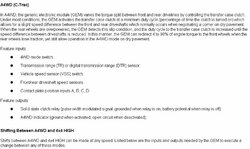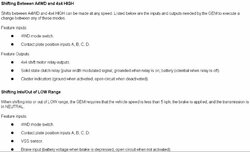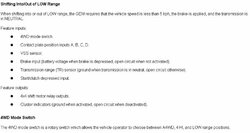gijoecam
Village Idiot
- Joined
- May 31, 1999
- Messages
- 8,336
- Reaction score
- 17
- City, State
- Trenton, MI
- Year, Model & Trim Level
- 98 ExSport, '00 F-150
Dogfriend sparked a discussion in another thread that got me thinkin, and I wanted to do some more research and get some discussion going here.
So as not to hijack the other thread, this is where it started:
http://www.explorerforum.com/forums/showthread.php?p=1422405#post1422405
I understand the PWM as that makes perfect sense... by varying the pulse width, you vary the voltage, BUT, mechanically, how can 2.1V (roughly 13% of 14V) in 4high cause the wheels to hop and buck when making a tight turn in a parking lot? Mechanically, the transfer case has to be locked-up, regardless of what that voltage is, no?
Granted, all I can measure is the voltage, so I'm not seeing the duty cycle called for by the GEM, but as you mentioned, the voltage I measured is a function of the duty cycle, with a roughly linear relationship between 0 and 100%, right? That means that 0V at the brown wire is 0% duty cycle and 14V is 100% duty cycle, right? Everything in between is roughly a linear relationship, no? (i.e. 50% duty cycle should result in roughly 7V)
Here's what I just found out on the drive.
In 4 auto
Idle---0.740V
Rolling---- variable with throttle position and speed, everywhere from .74v to 14V when rear wheels are slipping.
Anytime the rear wheels were spinning, the voltage was 14V.
I did a brake torque just for the heck of it, and found that the max voltage at WOT with the rear wheels stationary was 5.8V.
4High
Idle and stopped---- 2.1V
Rolling less than 12 mph---- 2.1V
Rolling more than 12 mph, any throttle position---14.0V
4Low
Idle---2.1V
Moving at all, or any throttle--- 14V
So, what's that mean? I dunno.... This is why I wanted to open a new thread for some discussion. Basically, it appears that the GEM varies the pulse width, which, of course, varies the voltage at the clutch (which we already knew from numerous other discussions, and is evidence by the varying brightness of the LED for those of us that used a lighted switch for the BWM).
But, mechanically, is the transfer case locked, unlocked, or allowing some amount of slippage? Based on my limited knowledge of the inner workings of the case, I don't see how varying the voltage (and of course, the amperage) to the TCCC will vary the amount of torque sent to the front wheels. That would require something less than a 50/50 power split, which would also mean the clutches in the t-case were slipping as well.
Beyond that, in 4auto, as soon as any wheel slippage is detected, the voltage spikes to 100% (14V), which tells me that the TOD relay is telling the transfer case to lock completely (at least momentarily), right?
I really wish there was someone over at Borg-Warner that could answer these questions, or someone in the PDC I could talk to that designed this PITA system!!
-Joe
So as not to hijack the other thread, this is where it started:
http://www.explorerforum.com/forums/showthread.php?p=1422405#post1422405
I understand the PWM as that makes perfect sense... by varying the pulse width, you vary the voltage, BUT, mechanically, how can 2.1V (roughly 13% of 14V) in 4high cause the wheels to hop and buck when making a tight turn in a parking lot? Mechanically, the transfer case has to be locked-up, regardless of what that voltage is, no?
Granted, all I can measure is the voltage, so I'm not seeing the duty cycle called for by the GEM, but as you mentioned, the voltage I measured is a function of the duty cycle, with a roughly linear relationship between 0 and 100%, right? That means that 0V at the brown wire is 0% duty cycle and 14V is 100% duty cycle, right? Everything in between is roughly a linear relationship, no? (i.e. 50% duty cycle should result in roughly 7V)
Here's what I just found out on the drive.
In 4 auto
Idle---0.740V
Rolling---- variable with throttle position and speed, everywhere from .74v to 14V when rear wheels are slipping.
Anytime the rear wheels were spinning, the voltage was 14V.
I did a brake torque just for the heck of it, and found that the max voltage at WOT with the rear wheels stationary was 5.8V.
4High
Idle and stopped---- 2.1V
Rolling less than 12 mph---- 2.1V
Rolling more than 12 mph, any throttle position---14.0V
4Low
Idle---2.1V
Moving at all, or any throttle--- 14V
So, what's that mean? I dunno.... This is why I wanted to open a new thread for some discussion. Basically, it appears that the GEM varies the pulse width, which, of course, varies the voltage at the clutch (which we already knew from numerous other discussions, and is evidence by the varying brightness of the LED for those of us that used a lighted switch for the BWM).
But, mechanically, is the transfer case locked, unlocked, or allowing some amount of slippage? Based on my limited knowledge of the inner workings of the case, I don't see how varying the voltage (and of course, the amperage) to the TCCC will vary the amount of torque sent to the front wheels. That would require something less than a 50/50 power split, which would also mean the clutches in the t-case were slipping as well.
Beyond that, in 4auto, as soon as any wheel slippage is detected, the voltage spikes to 100% (14V), which tells me that the TOD relay is telling the transfer case to lock completely (at least momentarily), right?
I really wish there was someone over at Borg-Warner that could answer these questions, or someone in the PDC I could talk to that designed this PITA system!!
-Joe


















